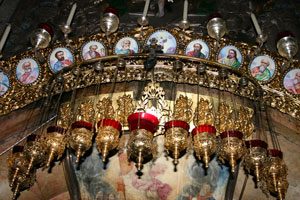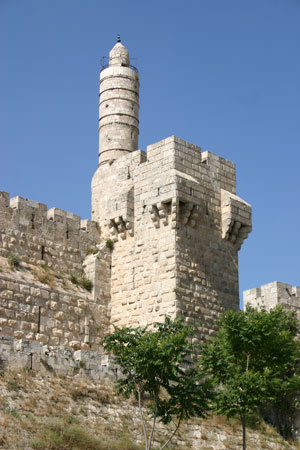JERUSALEM - It’s a story that’s been told many times and one well worth repeating, because its shows the power this city has on even the most famous of people who visit it.
Neil Armstrong, the first human to walk on the moon and a deeply religious man, visited Israel’s capital in 1988, a short time after accomplishing his historic lunar feat and asked his guide – a local professor – to take him to a place where the guide was certain Jesus had walked.
Ora Shlesinger, our Jerusalem guide and a student of the professor who acted as Armstrong’s guide that day, related the astronaut’s story as we stood on the steps of what remains of the temple built by Herod the Great.
“My professor brought Armstrong here,” said Shlesinger, a Sophia Loren look-alike, “because this was the place all Jews came to pray – and lest we forget Jesus was a Jew.”
"My professor told Armstrong: 'these steps were the main entrance to the temple. Jesus stood on these steps, of that we are certain."' The professor then reported that Armstrong went into deep prayer. A few minutes later, the emotional astronaut turned to his guide and said: "It means more to me to stand on these steps than to stand on the moon."
Jerusalem evokes that kind of passion from visitors, be they religious pilgrims, history buffs or world-famous astronauts. And it's a place that puts travellers over the moon with its dazzling collection of treasures dating back some 3,000 years.
The steps are the only things that survived the temple’s destruction by the Romans in 70AD and now sit in the shadow of the world-famous al-Aqsa Mosque, one of many sites which help draw a eclectic mix of religious pilgrims to this city. But religion is not all this holy city has to offer.

Above: The city is full of religious relics from every denomination.
The labyrinth of narrow streets that snake through the bustling Old City bazaar, where biblical icons once walked, remain filled with merchants whom, like their ancestors long before, sell wares in cramped street level shops that date back to the beginning of Jerusalem.
On the streets outside the Old City walls, stylish outdoor cafes are filled with young adults in T-shirts, who stand out among the holy men wearing cassocks, habits and black hats and coats. They sip thick black Turkish coffee and debate the political or religious topic of the day.
Oral knows the city like the back of her hand – “maybe better,” she assured us as we stepped though the entrance of the Davidson Centre, a new museum built on the remains of an Umayyad Palace near the impressive al-Aqsa Mosque and the legendary Moors' Gate.
"The Davidson Centre is a perfect spot to start a tour of the Old City because it explains a lot of the city’s history using wonderful displays and films," said Ora.
The displays were every bit as informative and entertaining as Ora had predicted. And a tour of the neighbouring archeological park, where artifacts dating back to the Roman and Byzantine periods have been unearthed, left us awestruck.
After a brief respite, we headed to the Church of the Holy Sepulchre, first passing through Jaffa Gate, where we were greeted by an army of vendors pushing everything from rugs to religious objects.
"Times have been tough for these people in recent years so they are more aggressive with the tourists who come," said Ora as we continued along the bazaar's narrow streets.
"You must bargain with these vendors - talk them down at least 50 per cent from their original asking price,” she told us.
“And please, watch your valuables. There are thieves here who, like in all tourist spots in the world, will pick your pocket.
“But our thieves are kind people,” said Ora with a chuckle before relating another of her wonderful tales about this fascinating city.
“One day I was leading a tour group through the Old City and one of the women noticed her wallet had been stolen from her purse. The wallet contained the only photographs she had of her dead husband and she was distraught,” remembered Ora.
“So I sought out the king of the thieves (apparently Jerusalem’s pick pockets have a regal leader) and told him how important it was for the woman to get those photographs back. She didn’t care about the money taken, just the pictures.”
Before the tour ended, the wallet, complete with the photographs and all of the woman’s money, was dropped back into her bag without her ever knowing.
Some good-natured Arab merchants offered us a 50 per cent discount if we’d buy their religious objects but Ora was intent on getting us to the Church of the Holy Sepulchre before the late afternoon crush of tourists arrived at the place of Jesus’ tomb.

Above: The old walls of the historic city look as good as new.
Soon we were standing at the entrance of Christianity's holiest place, the church which encompasses the site where Jesus was crucified and his body later laid to rest. Teary-eyed visitors wept and hugged openly as they exited the humble mountain grotto.
People carried tiny crosses and prayer beads into the cramped chamber, laid the objects on the marble slab that covers His tomb and offered up prayers.
Whether Christian or non-Christian, it is hard not to be moved when you enter the small crypt.
The Empress Helena ordered the church built over Christ's tomb in the year 333. Winding stone staircases within the church lead us to the site of the crucifixion. It's hard to believe so much history is housed in such a compact place.
We waited for a mass to finish before exploring a hole under the altar, which is believed to be the very spot where Christ's Cross was erected.
A walk down the Via della Rosa, the route Jesus took to his crucifixion, was another moving experience in Jerusalem, as was our visit to the Western Wall (or Wailing Wall), one of Judaism's holiest place.
Hundreds of Jewish men, most dressed in Orthodox black suits, white shirts and black hats, were gathered at the base of the heavily guarded Wall when we arrived. Off to the side, a group of women prayed at a section cordoned off for them.
"Write a message or prayer and take it to the Wall," Ora encouraged me. "Leave it in one of the cracks."
The tradition of leaving notes on the Western Wall has been going on for centuries. One reason is because the Talmud teaches that all prayers ascend to heaven through Jerusalem, so leaving a prayer or message in the Wall, as one professor noted, is like having a continual link.